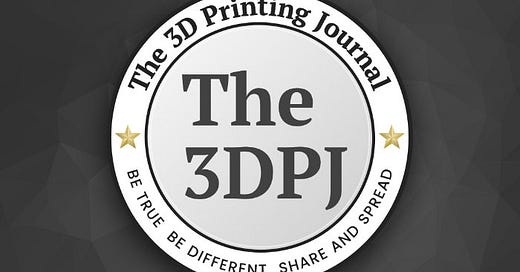5 trends in software that will transform additive manufacturing
The Atomic Layers: S8E31 (00237)
Atomic Layer of the Day:
Continuing the discussion on software in additive manufacturing, today we will focus on the trends shaping its development. As I mentioned yesterday, AM software extends far beyond just 3D design (CAD) and preparing models for 3D printing (slicing).
To elevate the technology to a higher level of adoption in industrial manufacturing, every element must be infused with modern software to increase repeatability, reduce errors and failed jobs, and automate processes.
Below, I list five areas where modern software tools will determine the success of AM in industrial production.
AI-driven process optimization
Since the early days, the success of 3D printing has depended equally on the quality of the 3D printer and its operator. Whether it was a machine worth hundreds of thousands of dollars or an amateur RepRap for $200, human factors always played a decisive role in success.
Years have passed, yet in certain technologies—such as metal 3D printing—nothing has changed in this regard. The failure rate ranges from several to dozens of percent. 3D prints fail either at the printer level or are discovered to be defective after post-processing.
Something could have been designed differently, positioned differently on the build platform, or supported with more or fewer structures.
Machine learning has a transformative impact here. Through print process simulations, AI predicts potential printing job issues and adjusts print settings or even suggests design modifications. This way, print failures occur on the computer screen rather than after opening the build chamber four days into a print job.
Automated end-to-end workflow management
As I mentioned yesterday, the vast majority of programs focus primarily on 3D printers. This is, of course, very important—nesting, emergency job transfers to available printers, build chamber utilization, and detailed reporting and analysis.
AI is also useful for this.
But it’s not enough. The process of part production is not just 3D printing—it also involves numerous other manufacturing processes. This requires dedicated tools as well. The nPower Scheduler allows for managing all pre- and post-printing processes. Allegedly, Oqton MOS also provides this functionality (I haven’t checked it yet—this is based on feedback from a commenter on my previous post).
Cloud-based and decentralized manufacturing platforms
Instead of sending dozens of inquiries to numerous subcontractors (who must first be identified), it can all be done via a single platform like Xometry or Replique.
This solution enables distributed production across multiple local manufacturing sites instead of centralizing it in one location. This leads to faster product delivery, reduced transportation costs, and greater flexibility.
Production takes place closer to the customer, shortening the supply chain and reducing dependency on large factories—replacing centralized plants with a network of smaller, specialized production centers.
Advanced simulation and digital twin integration
Advanced simulation and digital twin technology are key to modern additive manufacturing, significantly improving the design, production, and quality control processes. The integration of these tools allows for virtual testing and process optimization before physical execution, resulting in time, material, and cost savings.
Advanced simulation in additive manufacturing includes modeling material behavior during 3D printing, analyzing thermal stresses, and predicting potential structural defects.
A digital twin is a virtual replica of a physical object or process that updates in real-time using data from sensors and monitoring systems. In additive manufacturing, a digital twin can simulate not only the printing process but also the entire product lifecycle—from design through production to usage. Integrated with IoT (Internet of Things) systems, digital twins enable real-time tracking of machine performance, material consumption, and part quality. This allows for rapid anomaly detection and process adjustments.
Cybersecurity and blockchain for IP protection
AM, relying on digital design files and distributed production networks, is particularly vulnerable to threats such as data theft, unauthorized copying of designs, or production sabotage. In this context, blockchain technology and advanced cybersecurity solutions play a key role in securing sensitive data and processes.
Blockchain, best known from cryptocurrency applications, is increasingly being used in AM to protect intellectual property. This technology is based on a decentralized and immutable distributed ledger (DLT) that records all transactions and modifications transparently and irreversibly. In 3D printing, blockchain can track a project’s lifecycle—from creation through modifications to final production. Each change in the file is recorded as a data block, ensuring full auditability and preventing unauthorized modifications. This allows companies to prove design authorship, protect patents, and control who can access and use their intellectual property.
Cybersecurity, on the other hand, encompasses a wide range of actions aimed at protecting systems, networks, and data from cyberattacks. Since AM processes often rely on cloud computing and remote file transfers, they are vulnerable to hacking attempts, such as design theft, print parameter sabotage, or malware infections. To counter these threats, advanced encryption methods, multi-level authentication, and real-time anomaly detection systems are employed. In decentralized production, where multiple entities access the same resources, it is also crucial to manage permissions and control who can modify designs.
Atomic Layer from the Past:
‘2013 in AM’ - brand new history book! GET IT NOW!
News & Gossip:
UltiMaker released Cura 5.10.0, featuring enhanced slicing, new hardware support (including the high-speed S8 printer), and improved UI. The update introduces Cheetah Motion Planner, faster G-code, and native 3Dconnexion device integration. Optimized layer preview, G-code post-processing, and bug fixes are also included. macOS 12+ is now supported.
Bondtech has unveiled INDX, a wireless toolchanger set to launch at Formnext 2025. It features a smart toolhead switching between passive tools in 12 seconds, heating in four. With tools at ~$35 and the head at ~$250, it promises multi-material efficiency. Early testers can sign up on Bondtech’s website.
On Reddit, a user shared a dramatic story about a fire in which they allegedly lost their family’s assets due to a failure of the Qidi Plus4 3D printer. WARNING! This is just a Reddit post by an anonymous user, so we must take it with a grain of salt—such as simply taking their word for it. Additionally, they were permanently banned from r/QidiTech3d after reporting their story. Other users have reported similar issues. The user criticizes Qidi for poor safety measures and banning them instead of addressing concerns. Click here to look those horrible photos…






Good stuff sir!